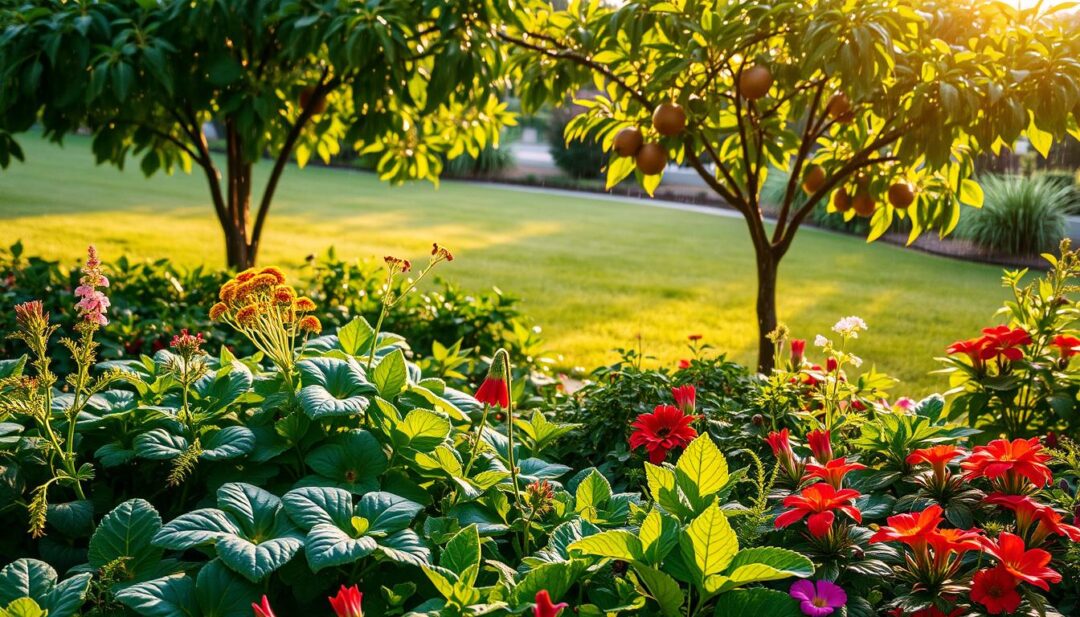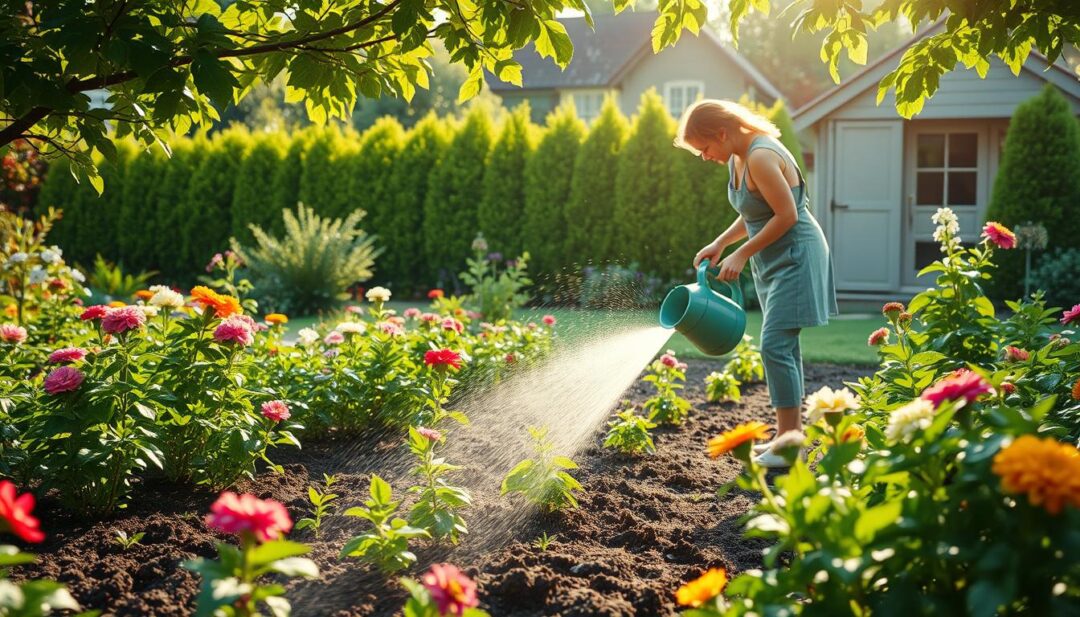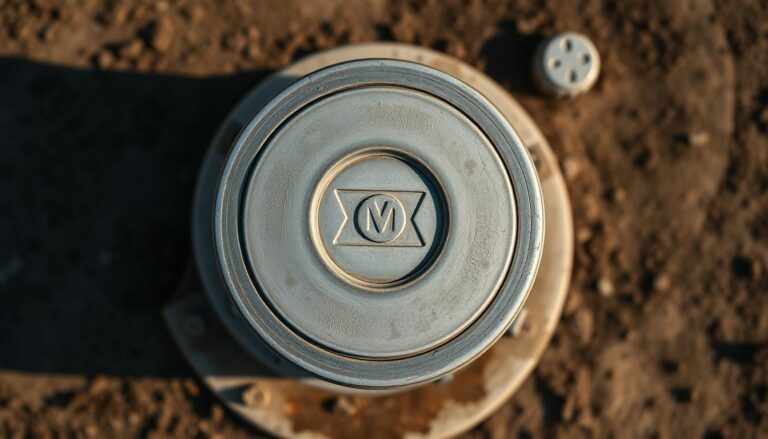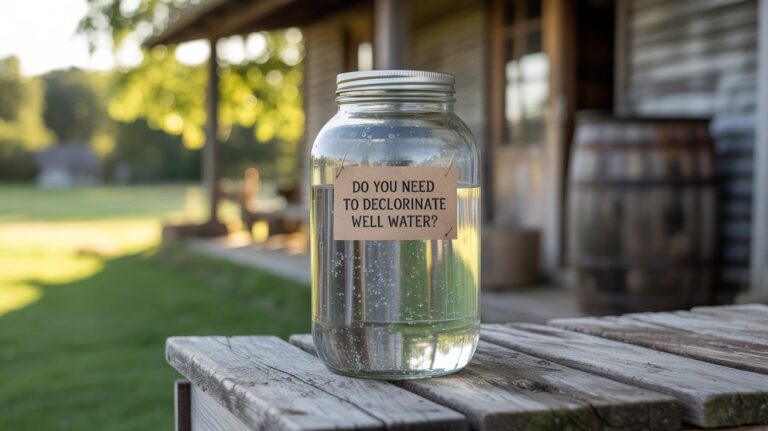What is a Well-Watered Garden?
Can a garden be more than just a collection of plants? Does it hold a deeper significance in our lives?
A well-watered garden is often seen as a symbol of spiritual nourishment and guidance, as referenced in Isaiah 58:11. The concept promotes gardening and community development, highlighting the importance of watering a garden for its growth and sustainability.
This idea is not just about the physical act of watering but also about the spiritual and communal aspects it represents.
Key Takeaways
- A well-watered garden symbolizes spiritual growth and guidance.
- Watering is crucial for the garden’s sustainability.
- The concept promotes community development through gardening.
- It represents both physical and spiritual nourishment.
- Gardening can have a deeper significance in our lives.
What Is a Well-Watered Garden: Definition and Characteristics
Achieving a well-watered garden is a balance of art and science, requiring careful attention to watering practices. A well-watered garden is characterized by its ability to maintain optimal moisture levels, supporting healthy plant growth and vibrant garden aesthetics.
Maintaining a healthy garden through proper watering is crucial for reaping the well watered garden benefits. It’s not just about providing enough water, but also about doing so in a way that supports the overall health and productivity of the garden.
Visual Signs of a Well-Watered Garden
A well-watered garden is visually appealing, with plants that are lush and vibrant. The leaves are a healthy green color, and the stems are sturdy. Flowers bloom vibrantly, and the overall garden atmosphere is lush and inviting.
The Balance Between Under-Watering and Over-Watering
One of the key challenges in maintaining a well-watered garden is finding the balance between under-watering and over-watering. Under-watering can lead to wilted plants and stunted growth, while over-watering can cause root rot and other problems. Employing best watering practices for gardens helps in achieving this balance.
Maintaining a healthy garden with watering involves understanding the specific needs of your plants and adjusting your watering schedule accordingly. This might involve checking soil moisture regularly and being mindful of weather conditions.
The Science Behind Garden Hydration
To cultivate a well-watered garden, it’s essential to delve into the science that governs how plants absorb and utilize water. Garden hydration is a multifaceted process that directly impacts plant health and productivity.
How Plants Absorb and Use Water
Plants absorb water primarily through their roots, a process driven by the roots’ ability to uptake water from the surrounding soil. This water is then transported to various parts of the plant, where it’s used for photosynthesis, growth, and development. The importance of soil moisture cannot be overstated, as it directly affects the plant’s ability to carry out these vital functions.
For more insights on optimizing water use in gardens, visit Unlocking the Benefits of Well Water for Thriving.
The Role of Water in Plant Growth and Development
Water plays a crucial role in plant growth and development. It’s a reactant in photosynthesis, the process by which plants produce their food, and it helps regulate plant temperature. Adequate water supply ensures that plants can grow vigorously and resist disease and pests more effectively.
- Water is essential for photosynthesis, allowing plants to produce energy.
- It helps in the transportation of nutrients from the soil to the plant.
- Adequate water supply supports healthy plant growth and development.
Understanding the importance of soil moisture and knowing how to properly water a garden are fundamental skills for any gardener. By mastering these aspects, gardeners can significantly improve the health and productivity of their gardens.
Benefits of Maintaining a Well-Watered Garden
The benefits of a well-watered garden are numerous, ranging from improved plant health to enhanced aesthetics. Maintaining the right balance of water in your garden can lead to a more vibrant and thriving landscape.

Improved Plant Health and Productivity
A well-watered garden ensures that plants receive the right amount of moisture to carry out their physiological processes efficiently. This leads to healthier plants that are more productive and less susceptible to stress.
Proper watering practices help in maintaining the nutrient balance in the soil, which is crucial for plant growth and development. As a result, plants are more likely to flourish and produce abundant flowers or crops.
Enhanced Garden Aesthetics
A garden that is well-watered tends to have a more vibrant and appealing appearance. Lush foliage and blooming flowers contribute to the overall beauty of the garden, making it a pleasant spot for relaxation and recreation.
The visual appeal of a well-maintained garden can also enhance the overall value of your property, making it more attractive to visitors and potential buyers.
Reduced Pest and Disease Problems
Maintaining a well-watered garden can help reduce the incidence of pests and diseases. Healthy plants are more resilient to pest attacks and less likely to be affected by diseases.
Proper watering practices can also help prevent the spread of diseases by reducing the moisture that many pathogens require to thrive. This creates a healthier environment for your plants to grow.
In conclusion, the benefits of maintaining a well-watered garden are multifaceted, contributing to a healthier, more productive, and aesthetically pleasing outdoor space. By understanding and implementing proper watering practices, gardeners can enjoy a thriving garden that enhances their quality of life.
Understanding Your Garden’s Water Needs
To keep your garden flourishing, it’s essential to comprehend its specific water requirements. A garden’s water needs are influenced by several factors, and understanding these factors is crucial for maintaining optimal hydration.
Factors Affecting Water Requirements
Several elements contribute to a garden’s water needs. These include:
Climate and Weather Conditions
Weather conditions such as temperature, humidity, and rainfall significantly impact a garden’s water requirements. For instance, gardens in hotter climates require more water than those in cooler climates.
Soil Type and Composition
The type of soil and its composition play a crucial role in determining water needs. Soil with high sand content drains quickly, requiring more frequent watering, while clay soils retain water longer, needing less frequent watering.
Plant Types and Growth Stages
Different plants have varying water needs, and their growth stages also affect their water requirements. For example, plants in their flowering stage often require more water than those in their dormant stage.
| Factor | Impact on Water Needs |
|---|---|
| Climate | Hotter climates increase water needs |
| Soil Type | Sandy soils require more frequent watering |
| Plant Type | Different plants have varying water requirements |
Signs of Improper Watering
Recognizing the signs of improper watering is vital for adjusting your watering schedule. Both under-watering and over-watering can be detrimental to your garden’s health.
Symptoms of Under-Watering
- Wilting or droopy leaves
- Dry, crispy leaf edges
- Slow growth
Symptoms of Over-Watering
- Yellowing leaves
- Waterlogged soil
- Root rot
By understanding these factors and recognizing the signs of improper watering, you can create an effective watering schedule that meets your garden’s specific needs, ensuring it remains healthy and thriving.
Essential Tools for Proper Garden Water Water
To keep your garden well-watered, it’s essential to have the right tools at your disposal. Proper garden watering is not just about providing enough water, but also about doing so in a way that is efficient and beneficial for your plants.
Manual Watering Equipment
Manual watering equipment offers a straightforward and cost-effective way to water your garden. This includes watering cans, hoses, and sprayers. Watering cans are ideal for small gardens or for targeting specific plants, while hoses with sprayers can cover larger areas and provide a more efficient way to water.
When choosing manual watering equipment, consider the size of your garden and the type of plants you have. For example, delicate plants may require a gentle spray, while larger plants or those in bigger areas may need a more robust watering system.
Automated Irrigation Systems
For a more convenient and potentially water-efficient solution, consider installing an automated irrigation system. These systems can be programmed to water your garden at optimal times, reducing evaporation and runoff. They can be particularly useful for larger gardens or for gardeners who want to ensure their garden is watered even when they’re away.
Automated irrigation systems come in various forms, including drip irrigation and sprinkler systems. Drip irrigation delivers water directly to the roots of the plants, minimizing waste, while sprinkler systems can cover larger areas and can be adjusted for different watering needs.
Moisture Meters and Monitoring Devices
Understanding the importance of soil moisture in gardening is crucial for effective watering. Moisture meters and other monitoring devices can help you determine the moisture level in your soil, ensuring you’re not over or under-watering your plants. These tools can be especially valuable in areas with variable weather conditions or for plants with specific watering needs.
By combining the right watering equipment with monitoring devices, you can implement best watering practices for gardens. This not only promotes healthy plant growth but also contributes to water conservation, making your gardening practices more sustainable.
Creating an Effective Watering Schedule
A well-planned watering schedule is the backbone of a thriving garden, ensuring that your plants receive the right amount of moisture. To achieve this, it’s crucial to consider several factors that influence your garden’s watering needs.
Seasonal Watering Adjustments
As the seasons change, so do the watering needs of your garden. During the summer months, plants typically require more water due to increased evaporation and growth rates. In contrast, winter months often necessitate less frequent watering because of lower temperatures and reduced plant activity.
To adjust your watering schedule accordingly, consider the following:
- Monitor weather forecasts to anticipate and prepare for extreme weather conditions.
- Observe your plants for signs of stress or waterlogging.
- Adjust your watering frequency based on soil moisture levels.
Time of Day Considerations
The time of day you water your garden can significantly impact its effectiveness. Watering in the early morning or late evening reduces evaporation, ensuring that more water is absorbed by the soil. Avoid watering during the peak sun hours to minimize loss through evaporation.
Frequency vs. Duration of Watering
Deciding whether to water your garden frequently or for longer durations depends on your plants’ specific needs and soil type. Deep watering encourages deep root growth, making plants more resistant to drought. However, shallow, frequent watering can lead to weak root systems.
To strike the right balance, consider the following tips:
- Water plants deeply but infrequently to promote healthy root development.
- Check soil moisture by inserting a finger into the soil or using a moisture meter.
- Adjust your watering schedule based on the specific needs of different plants in your garden.
Water Conservation Techniques for Sustainable Gardens
Implementing water conservation techniques is crucial for maintaining a sustainable garden. By adopting these methods, gardeners can significantly reduce their water usage while keeping their gardens healthy and thriving.
One of the most effective ways to conserve water in gardens is through mulching for moisture retention. Mulch acts as a barrier, reducing soil evaporation and runoff. Organic mulches like wood chips, bark, or straw are particularly effective as they also improve soil health over time.
Mulching for Moisture Retention
Mulching is a simple yet powerful technique for retaining soil moisture. By applying a layer of mulch around plants, gardeners can reduce the need for frequent watering. This method not only conserves water but also suppresses weeds and regulates soil temperature.
For optimal results, it’s essential to choose the right type of mulch and apply it correctly. A thickness of 2-3 inches is generally recommended, and it’s crucial to keep the mulch a few inches away from plant stems to prevent rot.
Rainwater Harvesting Systems
Another effective water conservation technique is installing rainwater harvesting systems. These systems collect and store rainwater for later use, reducing the demand on municipal water supplies. Rainwater is also free from many chemicals found in tap water, making it ideal for irrigation.
Gardens can benefit greatly from rainwater harvesting by having a natural source of water that’s perfect for plants. This method not only conserves water but also helps in reducing stormwater runoff.
Drought-Tolerant Landscaping Strategies
For areas prone to drought, adopting drought-tolerant landscaping strategies can be highly beneficial. This involves selecting plants that are adapted to dry conditions and require less water. Such plants often have deep roots or specialized leaves that help them conserve water.
Drougth-tolerant landscaping not only reduces water consumption but also decreases the need for fertilizers and pesticides, creating a more sustainable garden ecosystem.
Soil Management for Optimal Water Retention
Managing soil effectively is the backbone of a well-watered and thriving garden. Soil management techniques play a crucial role in optimizing water retention, which is essential for maintaining a healthy garden.
Improving Soil Structure is a fundamental aspect of soil management. The structure of the soil determines its ability to retain water. Techniques such as adding organic matter and reducing tillage can significantly improve soil structure, allowing it to hold more water.
Improving Soil Structure
To improve soil structure, gardeners can adopt several practices. One effective method is to incorporate organic matter into the soil, which enhances its water-holding capacity. Another approach is to minimize soil disturbance through reduced tillage, preserving soil pores and promoting root growth.
| Soil Structure Improvement Techniques | Benefits |
|---|---|
| Adding Organic Matter | Enhances water-holding capacity, improves soil fertility |
| Reducing Tillage | Preserves soil pores, promotes root growth, reduces erosion |
Organic Matter and Compost Benefits
Organic matter and compost are vital for improving soil’s water retention capabilities. They act like a sponge, absorbing and holding water, making it available to plants as needed. Additionally, organic matter improves soil’s fertility and structure, supporting healthy plant growth.
Addressing Drainage Issues
Proper drainage is essential to prevent waterlogged soil, which can be detrimental to plant health. Gardeners should assess their soil’s drainage and take corrective measures if necessary. This may involve installing drainage systems or adjusting the soil’s structure to improve its permeability.
By implementing these soil management strategies, gardeners can optimize water retention, reduce waste, and promote a healthy and thriving garden.
Troubleshooting Common Watering Problems
The path to a thriving garden involves understanding and addressing common watering issues. Proper watering is a delicate balance that, when achieved, can significantly enhance the health and aesthetics of your garden.

Dealing with Drought Conditions
Drought conditions can severely impact your garden’s health. To mitigate this, it’s essential to adopt drought-tolerant landscaping strategies and implement efficient watering practices.
One effective method is to use mulch to retain soil moisture. Mulch acts as a barrier, reducing evaporation and keeping the soil cooler. Additionally, incorporating organic matter into the soil can improve its water-holding capacity.
Managing Waterlogged Gardens
On the other end of the spectrum, waterlogged gardens can be just as detrimental. To manage this issue, it’s crucial to improve drainage and avoid overwatering.
Ensuring that your garden has proper drainage systems in place can prevent water from accumulating. You can also consider using raised beds to improve drainage and reduce the risk of waterlogging.
Addressing Uneven Water Distribution
Uneven water distribution is another common issue that gardeners face. This can be due to a variety of factors, including poor irrigation system design or inconsistent watering practices.
To address this, it’s essential to assess your irrigation system and make necessary adjustments. Using moisture meters can help you monitor soil moisture levels and ensure that water is being distributed evenly.
By understanding and addressing these common watering problems, you can maintain a healthy, thriving garden. Implementing the right strategies and practices will help you achieve the best watering practices for your garden.
Conclusion: Nurturing Your Well-Watered Garden
Maintaining a well-watered garden is a continuous process that requires attention to detail and a commitment to providing your plants with the right amount of water. By understanding what is a well-watered garden, you can create a thriving outdoor space that brings numerous benefits, including improved plant health and aesthetics.
A well-watered garden is not just a matter of watering your plants regularly; it’s about striking the right balance between under-watering and over-watering. By following the tips and techniques outlined in this article, you can enjoy the well-watered garden benefits, such as reduced pest and disease problems and enhanced garden productivity.
To keep your garden thriving, remember to monitor your plants’ water needs, adjust your watering schedule seasonally, and use efficient irrigation systems. With ongoing care and attention, you can nurture your well-watered garden and enjoy its many rewards for years to come.







